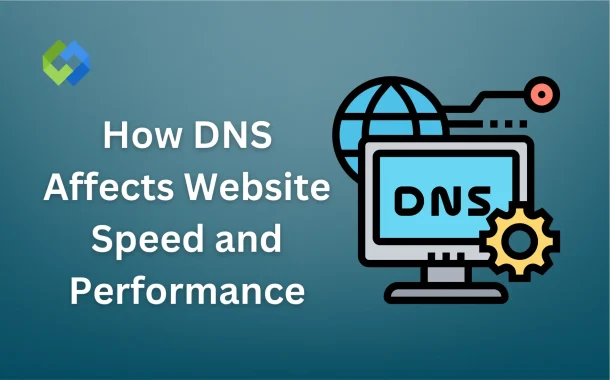This means a catastrophe for your business, a bad brand reputation, and a lot of lost earning opportunities. This raises the question: What is DNS, and how can you keep it sorted to avoid affecting your site’s speed and performance?
Find answers to these questions (and more) in this post, where we explore these ideas in depth, providing you with all the information possible in one place.
Table of Contents
Table of Contents
What is DNS and Why Does It Matter?
DNS works like a phonebook of the internet. When users type a URL (like www.example.com) into their browser, DNS translates it into the IP address of the server hosting that website.
Then, your browser is connected to that platform, allowing you to access the data on the page without any problems. This process ensures that users can access websites without needing to memorize complex strings of numbers like 192.168.2.1., or something along those lines.
The efficiency of this DNS “lookup” process directly impacts website speed. A slow or poorly configured DNS infrastructure can lead to delays. This can increase your site’s load time and potentially drive users away.
How are DNS Resolution and Website Speed Related?
There is quite a close relationship between DNS resolution time and the site’s speed and performance.
In simpler terms, DNS resolution refers to how long it takes to translate a domain name into its corresponding IP address. While this may seem like a minor process, a slow DNS lookup can significantly increase the time it takes to load your website.
Below are some ways in which DNS resolution affects the speed and performance of your site. Read them closely to avoid missing out on anything crucial.
- Longer Time-to-First-Byte (TTFB): TTFB is directly linked with a slow DNS resolution. Delays can occur between the server and the browser showing data to the user, leading to poor site loading times.
- Caching Inefficiencies: If DNS records aren’t cached properly, repeated lookups for the same domain can slow down website performance, leading to a bad user experience.
- Multistep Delay: Remember, DNS lookup involves multiple steps. So, if you have a poorly configured DNS setup, it may add unnecessary lag at each step, making the site inaccessible at times.
Research shows that the optimal conversion rates for websites had a page load time of 0-4 seconds. Anything more than this can mean higher bounce rates.
Factors That Affect DNS Resolution
Many factors affect the DNS resolution of your websites. These are discussed in detail below.
Location of DNS Servers
The physical proximity of the DNS server to your users matters. If your DNS server is halfway across the world, it will take longer to respond to queries.
DNS Provider’s Quality
Not all DNS providers offer the same level of speed and reliability. This is why you should choose providers with a globally distributed network to reduce latency between user’s browsers and the servers caching the data.
Time to Live (TTL) Settings
TTL determines how long DNS records are cached before they are refreshed. A longer Time to Live reduces the number of overall lookups but might delay updates. So, choose this value with care.
DNS Record Types Used
Complex DNS records like CNAMEs (aliases for domains) add extra steps to the resolution process, while simpler ones like A or AAAA records work more efficiently.
Optimizing DNS for Speed
DNS optimization is critical for creating a fast and reliable user experience. Below, we have mentioned some of the tips you can apply to improve the DNS performance of your platforms in no time.
Choosing a High-Performance DNS Provider
Opt for a DNS provider with a large, geo-distributed network to minimize latency. Premium providers like Cloudflare, AWS, and Google Cloud DNS are excellent options. However, these can be a bit pricey, especially for small businesses.
Using DNS Caching
Enable DNS caching on both the client side (browser) and server-side. Cached records reduce repeated lookups and speed up the user experience.
Reducing CNAME Records
Replace CNAME records with A or AAAA records, when possible, to eliminate extra resolution steps and speed up the site performance.
However, these guidelines vary according to the type of business or platform you are running. So, it is better to consult professionals in this regard to make the best decisions possible.
Setting Optimal TTL Values
Balance TTL settings carefully. Use longer TTLs for stable records and shorter TTLs for records that change frequently to manage propagation times effectively.
Tools to Measure DNS Performance
Monitoring your DNS performance is essential for identifying bottlenecks and making improvements. But, for that, you need special tools and technologies to help you perform these processes quickly and efficiently.
whatsmydns.me
This online tool lets you check DNS propagation worldwide, ensuring that changes to your records are visible across global servers. It provides a map view of resolution statuses and supports multiple record types like A, CNAME, MX, etc.
Pingdom.com
Pingdom measures the speed of your DNS servers and identifies delays. Thus allowing you to fix problems and provide a better user experience on online platforms.
Google Lighthouse Chrome Extension
Modern times require exceptional mobile speeds, and the Google Lighthouse extension helps you achieve that with convenience. Its “mobile-ready” tests allow you to see potential bottlenecks in site loading times (including DNS resolution problems), allowing you to fix the issues immediately.
Case Studies of How DNS Optimization Has Improved Site Speed and Performance
Below, you’ll find some real-life case studies on how online platforms have found success by optimizing their DNS for better site speed and performance.
Case Study 1: University of Victoria
The University of Victoria is a medium-sized university (teaching and research) in Canada that experienced frequent crashing and resolution delays for its websites.
By centralizing its management of multi-vendor DNS and DHCP services, the institution, boasting over 22,000 students (undergraduate and graduate combined), was able to achieve high integrity of data and ease of access for its staff.
Case Study 2: Viettel
Viettel, a leading telecommunication company in the Middle East, was able to improve its operational efficiency by smoothing out its DNS resolution.
In particular, they worked on their DNS infrastructure by utilizing 40 F5 series appliances, each equipped with F5 BIG-IP DNS and F5 BIG-IP Advanced Firewall Manager (AFM).
Soon, Viettel was able to handle an increased number of user queries per day without experiencing any delays.
Case Study 3: DNS Made Easy
DNS Made Easy is a DNS provider founded by Steven Job in 2001. It provides reliable DNS services to small businesses, individuals, and brand-name customers.
However, in 2020, the company faced a major setback when they were attacked by a hacking group called ‘Fancy Bear.’ Their DDoS attacks hauled DNS Made Easy’s services and caused downtimes of up to 4 to 5 hours.
Seeing this, the enterprise decided to implement the latest DNS technologies, like universal routing, to achieve 100% uptime for its customers. Hence ensuring that their sites never suffer again due to bad speed or performance.
Final Words
Optimizing DNS is crucial for enhancing website speed and performance, as a slow DNS can lead to negative user experiences and financial losses for businesses.
Key factors affecting DNS resolution include server location, provider quality, and record types.
To improve performance, website owners should consider high-performance DNS providers, enable caching, and set optimal TTL values.
Utilizing monitoring tools like Middleware is also necessary to resolve any problems in the networks and provide the best possible user experience on online platforms.














